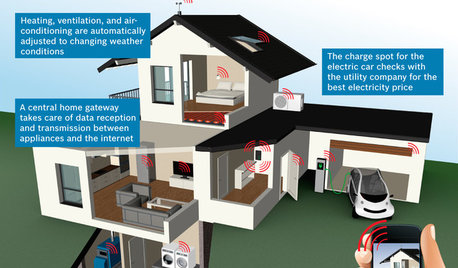Whole house surge protection device
eoz3106
12 years ago
Related Stories

HOME TECHTo Feed and Protect: Care for Your Pet From Afar With New Devices
You might miss the nuzzles, but your dog or cat won't miss food, water or monitoring with these high-tech feeders and cameras
Full Story
REMODELING GUIDES10 Tips to Maximize Your Whole-House Remodel
Cover all the bases now to ensure many years of satisfaction with your full renovation, second-story addition or bump-out
Full Story
THE HARDWORKING HOMECES 2015: Inching Toward a Smarter Home
Companies are betting big on connected devices in 2015. Here’s a look at what’s to come
Full Story
PATIOS6 Patio Cover Types to Shade You in Style
Protect yourself and your deck from the blazing sun with umbrellas, cloth, built structures — or nature's perfect shading solution
Full Story
LIFE7 Things to Do Before You Move Into a New House
Get life in a new house off to a great start with fresh paint and switch plates, new locks, a deep cleaning — and something on those windows
Full Story
HOME TECHIn Rarefied Air: Meet 3 Cutting-Edge Home Sensors
These new all-purpose sensors send alerts to your smart phone about temperature, air quality and a whole lot more. Why not?
Full Story
MOVINGThe All-in-One-Place Guide to Selling Your Home and Moving
Stay organized with this advice on what to do when you change homes
Full Story
GREEN BUILDINGZero Net Energy: A Hardworking-House Term to Know
Homes that consume only as much energy as they produce by renewable means are a goal for builders. Learn what ZNE means for you
Full Story
ARCHITECTUREDesign Workshop: 9 Ways to Open a House to the Outdoors
Explore some of the best ideas in indoor-outdoor living — and how to make the transitions work for both home and landscape
Full Story
FUN HOUZZ6 Reasons Every House Needs a Cat
Everyone should have a feline fixture as part of their home decor. Here's why
Full StoryMore Discussions








bus_driver
brickeyee
Related Professionals
Barrington General Contractors · Elmont General Contractors · Fremont General Contractors · Gainesville General Contractors · Grand Junction General Contractors · Hagerstown General Contractors · Kailua Kona General Contractors · Mountain View General Contractors · Oneida General Contractors · Rocky Point General Contractors · Selma General Contractors · Castle Rock Home Automation & Home Media · Mount Lebanon Home Automation & Home Media · Weatherford Home Automation & Home Media · Silver Spring Home Automation & Home Mediaeoz3106Original Author
brickeyee
westom
kurto
westom
brickeyee
westom
bud_
brickeyee
westom
brickeyee
bud_
brickeyee
westom
brickeyee
bud_
brickeyee
bud_
bud_
Scott Waschlerner